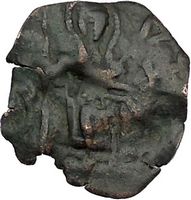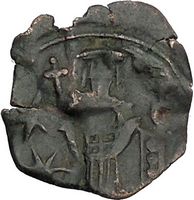Byzantine Empire
Andronicus II, Palaeologus - Byzantine Emperor: 11 December 1282 - 24 May 1328 A.D.
Bronze Trachy 19mm (0.79 grams) Thessalonica mint
Reference: Sear 2380
St. Demetrius standing facing.
Andronicus standing, holding large cross and labarum-headed scepter. You are bidding on the exact item pictured, provided with a Certificate of Authenticity and Lifetime Guarantee of Authenticity.  Saint Demetrius ofThessaloniki (Greek:Άγιος Δημήτριος της Θεσσαλονίκης) is aChristianmartyr of the early 4th century AD. Saint Demetrius ofThessaloniki (Greek:Άγιος Δημήτριος της Θεσσαλονίκης) is aChristianmartyr of the early 4th century AD.
During theMiddle Ages, he came to be revered as one of the most important Orthodoxmilitary saints, often paired withSaint George. Hisfeast day is 26 October for Eastern Orthodox Christians following theGregorian calendar and 8 November for those following theJulian calendar. The Roman Catholic church has no feast day for Saint Demetrius Andronikos II Palaiologos (25 March 1259,Nicaea –February 13, 1332,Constantinople) — also Andronicus II Palaeologus — reigned asByzantine emperor from 1282 to 1328. He was the eldest surviving son ofMichael VIII Palaiologos andTheodora Doukaina Vatatzina, grandniece ofJohn III Doukas Vatatzes.// 
Andronikos II Palaiologos was acclaimed co-emperor in 1261, after his father Michael VIII recoveredConstantinople from theLatin Empire, but he was crowned only in 1272. Sole emperor from 1282, Andronikos II immediately repudiated his fathers unpopular Church union with thePapacy (which he had been forced to support while his father was still alive), but was unable to resolve the related schism within the Orthodox clergy until 1310. Andronikos II was also plagued by economic difficulties and during his reign the value of the Byzantine hyperpyron depreciated precipitously while the state treasury accumulated less than one seventh the revenue (in nominal coins) that it had done previously. Seeking to increase revenue and reduce expenses, Andronikos II raised taxes and reduced tax exemptions, and dismantled the Byzantine fleet (80 ships) in 1285, thereby making the Empire increasingly dependent on the rival republics ofVenice andGenoa. In 1291, he hired 50-60 Genoese ships. Later, in 1320, he tried to resurrect the navy by constructing 20 galleys, but unfortunately he failed. Andronikos II Palaiologos sought to resolve some of the problems facing theByzantine Empire through diplomacy. After the death of his first wife, he marriedYolanda (renamed Eirene) of Montferrat, putting an end to the Montferrat claim to theKingdom of Thessalonica. Andronikos II also attempted to marry off his son and co-emperorMichael IX Palaiologos to the Latin EmpressCatherine I of Courtenay, thus seeking to eliminate Western agitation for a restoration of theLatin Empire. Another marriage alliance attempted to resolve the potential conflict with Serbia inMacedonia, as Andronikos II married off his five-year old daughterSimonis to KingStefan Milutin in 1298. In spite of the resolution of problems inEurope, Andronikos II was faced with the collapse of the Byzantine frontier inAsia Minor. After the failure of the co-emperor Michael IX to stem the Turkish advance in Asia Minor in 1300, the Byzantine government hired theCatalan Company ofAlmogavars (adventurers from Aragon andCatalonia) led byRoger de Flor to clear Byzantine Asia Minor of the enemy. In spite of some successes, the Catalans were unable to secure lasting gains. They quarreled with Michael IX, and eventually turned on their Byzantine employers after the murder of Roger de Flor in 1305, devastatingThrace, Macedonia, and Thessaly on their road to Latin Greece. There they conquered theDuchy of Athens andThebes. The Turks continued to penetrate the Byzantine possessions, andPrusa fell in 1326. By the end of Andronikos IIs reign, much of Bithynia was in the hands of theOttoman Turks of Osman I and his son and heirOrhan. Also,Karesi conquered Mysia region with Paleokastron after 1296, Germiyan conqueredSimav in 1328, Saruhan captured Magnesia in 1313 andAydınoğlu captured Symirna in 1310. The Empires problems were exploited byTheodore Svetoslav of Bulgaria, who defeated Michael IX and conquered much of northeastern Thrace in c. 1305-1307. The conflict ended with yet another dynastic marriage, between Michael IXs daughter Theodora and the Bulgarian emperor. The dissolute behavior of Michael IXs sonAndronikos III Palaiologos led to a rift in the family, and after Michael IXs death in 1320, Andronikos II disowned his grandson, prompting acivil war that raged, with interruptions, until 1328. The conflict precipitated Bulgarian involvement, andMichael Asen III of Bulgaria attempted to capture Andronikos II under the guise of sending him military support. In 1328 Andronikos III entered Constantinople in triumph and Andronikos II was forced to abdicate. He died as a monk in 1332. |






 Saint Demetrius ofThessaloniki (Greek:
Saint Demetrius ofThessaloniki (Greek:
